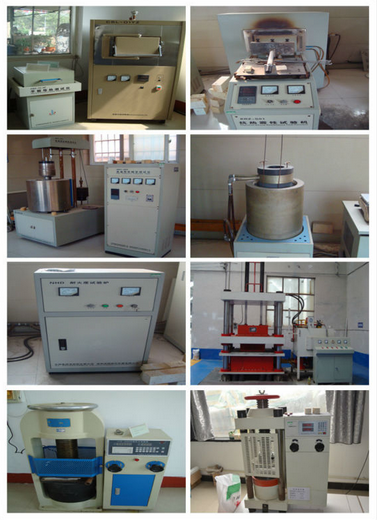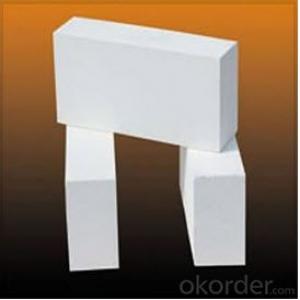High Alumina Brick - 75%-80% Al2O3 for Boiler/Klin Lining
- Loading Port:
- Tianjin
- Payment Terms:
- TT OR LC
- Min Order Qty:
- 3000 pc
- Supply Capability:
- 50000 pc/month
OKorder Service Pledge
OKorder Financial Service
You Might Also Like
75% -80% AL2O3 High Alumina Refractory Brick for Boiler/Klin Lining
Production description
High alumina refractory brick contain Al2O3 more than 60%, which is made of high grade bauxite through high temperature calcinations. Its refractories is usually above 1750 °C. The main mineral components are corundum and mullite phases. It is a kind of neutral refractory material so that it enjoys excellent resistance to acid and alkali corrosion. According to Al2O3 content,it can be divided into three degrees:The Al2O3 content is more than 75%.The Al2O3 content range from 60% to 75%.The Al2O3 content range from 48% to 60%.

products \index | code | Al2O3≥ | Fe2O3≤ | Bulk Density≥ | Apparent Porosity ≤ | Cold crushing strength ≥ | Refractoriness under load ≥(0.2Mpa) |
Unit | %
| g/cm3 | % | MPa |
°C | ||
High alumina brick | LZ-48 | 48 | 2.0 | 22 | 35 | 1420 | |
LZ-55 | 55 | 2.0 | 22 | 40 | 1450 | ||
LZ-65 | 65 | 2.0 | 23 | 45 | 1500 | ||
LZ-75 | 75 | 2.0 | 23 | 50 | 1520 | ||
LZ-80 | 80 | 1.8 | 22 | 55 | 1530 | ||
| phosphate combines high alumina bricks | P | 75 | 2.5 | 2.65 | 75 | 1350 | |
| PA | 77 | 2.5 | 2.70 | 75 | 1300 | ||
spalling resistance high alumina bricks.
| KSL-65 | 65 | 1.6 | 2.45 | 24 | 40 | 1500 |
| KBL-75 | 75 | 1.6 | 2.6 | 24 | 45 | 1520 | |


Features:
1. Low thermal conductivity, good thermal insulation performance.
2. Long service life, easy operation, could be shaped freely
3. Product specification: standard form, normal standard, shaped and special shaped bricks.
4. Can be used in various kilns because of its cheapness and general tray package. Among all of the refractory materials, it is the most widely used.
Application:
Refracory brick plant can be in direct contact with the flame,this insulating brick can be used as linings or as thermal preservation layers in various industrial furnaces and kilns in metallurgical industry, ceramic industry, chemical industry, machinery industry.
such as blast furnace, hot blast stoves ,electric arc furnace, cement kiln,melting furnace, ignition furnace, flue, refining equipment, heating equipment and piping, regeneration device, gas furnace, soaking furnace, annealing furnace, heat reaction chamber and other thermal industrial equipment.

FAQ
1. Do you provide samples?
Yes, samples are free. Guarantee samples quality same as mass production quality.
2. What's the MOQ of trial order?
No limit,We can offer the best suggestions and solutions according to your condition.
3. Can we visit your company?
Of course,welcome at any time,seeing is believing.
4. Do you accept OEM?
Yes, we can do OEM.
5. What are the payment terms?
Usually T/T, D/A, D/P, L/C, Western Union ,others could be discussed .
6. How long is delivery time?
The delivery time will be determined according to the quantity of the order.
7. How are your products’ quality?
More than 20 years of production experience. The products will be strictly inspected before shipment, so the quality could be guaranteed.
8. How to slove the quality problems?
If the products are not confirmed to customer samples or have quality problems,our compay will be responsible to make compensation for it.
9. What is the service life of your bricks?
The service life of different bricks is unlike.It also depends on your using condition and method.
10. How about your company's certification?
ISO9001 and Test Report,also we could apply other necessary certification.
11. How about your price?
Quality will be guaranteed. Competitive prices based on same quality.
- Q: How much is the bending temperature aluminum silicon carbide brick for torpedo car
- The product has the advantages of high temperature, little creep, strong corrosion resistance and good thermal shock resistance, and is suitable for large and medium-sized hot blast stoves.
- Q: What are the reasons for the spalling of refractory bricks in the production of lime kiln?
- In the course of the production of lime kiln, the local block of refractory brick is a very dangerous signal. It is suggested that you stop the kiln to prevent the collapse of a large area. Lime kiln is the main equipment for the production of limestone kiln and rotary kiln is two, with the growth of calcium carbide lime kiln industry, iron and steel industry, the construction industry to the amount of limestone has become the main production equipment, and refractory bricks became the heart of lime kiln.
- Q: What are the requirements for Rubble backfill height?
- 1, filling thickness is not greater than 50cm.2, filling, the use of layered filling.
- Q: How to make refractory bricks and boiler wall adhesion more firm?
- If the condition, the user heat-resistant steel welding grip nails, expansion joints can not be too big.. Also to use high temperature aluminum brick, high temperature resistance, but also to extend its use cycle.
- Q: What is the content of free silica in the refractory bricks of high alumina bricks?
- Refractory powders are not rich in free silica in varying degrees
- Q: What is the apparent porosity of high alumina brick?
- Total porosity is porosity refers to the total volume of sample porosity in the percentage of total volume of samples. Apparent porosity refers to the percentage of the total volume of openings, pores, and total specimens in the sample.
- Q: Does the chimney have high acid resistance?
- The chimney particles and gases, mostly coal tar products, material acidic, therefore, take good acid resistance, acid proof brick, Grouts also used potassium silicate clay acid is preferred.
- Q: How does the physicochemical index change when the high alumina brick is used at high temperature?
- When the high alumina brick is used at high temperature, the physical and chemical indexes and other constants will not change if the temperature is in the physical and chemical indexes and the softening temperature of the load.
- Q: What is the high temperature limit of refractory bricks and refractory soil?
- Refractory bricks are stone powder and clay paste. They are fired in a kiln of 1300 degrees. The upper limit is 1500 degrees above normal pressureRefractory bricks - refractory materials of a specified shape and size.
- Q: High alumina brick 80 with which high aluminum cement?
- Which kind should be chosen should be determined according to the conditions of use, life expectancy and cost control. By the way, the quality of masonry is also very influential.
Send your message to us
High Alumina Brick - 75%-80% Al2O3 for Boiler/Klin Lining
- Loading Port:
- Tianjin
- Payment Terms:
- TT OR LC
- Min Order Qty:
- 3000 pc
- Supply Capability:
- 50000 pc/month
OKorder Service Pledge
OKorder Financial Service
Similar products
Hot products
Hot Searches
Related keywords






























